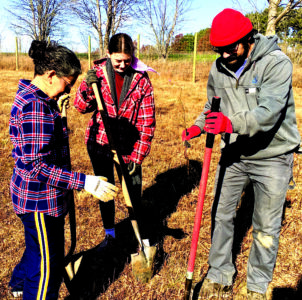Progress takes root at North Lima wildlife sanctuary
Volunteers plant 1,750 trees to fight climate-change effects

Correspondent photo / Sean Barron Mikey Guerrero of Howland, right; his mother, Holly Guerrero, left; and his fiancée, Emma Wicks, plant a shagbark hickory plant as part of Youngstown State University’s Legacy Forest’s tree-planting gathering Thursday in North Lima. Seventeen native species were seeded on the property, much of which Mill Creek MetroParks owns.
NORTH LIMA — Mikey Guerrero and one of his most significant roots were more than up to the task of working together to plant additional roots.
“We did at least 24 — eight each,” Guerrero, of Howland, said.
Joining Guerrero to dig holes then split planting two dozen tree varieties among them were his mother, Holly Guerrero, and his fiancee, Emma Wicks. The three of them also were among numerous Youngstown State University students, graduates and volunteers who rolled up their sleeves to be part of YSU’s Legacy Forest’s six-hour tree planting Thursday at the George L. Fordyce Wildlife Sanctuary off West Calla Road.
Others who volunteered to place seeds into the ground on a sunny, 50-degree day were Poland Seminary High School students, along with volunteers with the Mahoning County Land Bank, Mill Creek MetroParks and Boardman Subaru.
The goal was to plant 1,750 trees representing 17 native species: American basswood, black cherry, coffee, Eastern red cedar, black gum, hackberry, Ohio buckeye, white walnut, tulip tree, red maple, white pine, Osage orange, sycamore, shagbark hickory, white oak, persimmon and red maple.
Mikey Guerrero, a quality engineer with Ultium Cells in Lordstown, said a key influence in his decision to be part of Thursday’s plantings was one of his former teachers, Colleen McLean, a YSU environmental sciences professor. For her part, McLean brought two of her classes to the remote parcel that also is near the Ohio Turnpike.
Of the 1,750 trees that were planted on the nearly 500 acres, as part of a project to mitigate the effects of climate change and create a micro-forest, FirstEnergy Corp. donated 1,700 of them. The land bank donated the remaining 50, Rachel Sobnosky, the MetroParks’ natural resources manager, noted.
Beforehand, the acreage was largely an agricultural field with row farming. Today, courtesy of a Clean Ohio conservation fund grant, money was secured to build an 8-foot fence to surround the property where the new trees were planted in an effort to protect them from being eaten by white-tailed deer and other herbivores, she explained.
“The site was sprayed with herbicides, then planted with native pollinator seed mix,” Sobnosky said.
Tug Sanner busied himself with digging a hole to insert a small maple tree, but said he felt he also was planting something else of significance.
“It’s all part of our love promise and community commitment,” Sanner, an internet sales manager with Boardman Subaru, said, adding that such efforts are more important to him than selling cars.
Sanner, who earned a degree in natural resources from Hocking College near Nelsonville, said he also has collaborated with a number of conservation societies in ongoing efforts “to better the Earth.”
Teaming up with Sanner in the maple-planting effort was Rowen Silvers, a YSU freshman who plans to major in chemistry, with a minor in environmental science. Owning hundreds of acres is not a prerequisite for being proactive in tackling climate change, she said.
“This is something you can do in your own backyard,” Silvers said, adding that her career goals include research or advocacy related to environmental sustainability. “I hope to encourage people to try to make changes in their own lives, even if it’s small; one person, one step at a time.”
That mantra proved true regarding the efforts Thursday of Venky Boddu and Sachin Eluri, both of whom are YSU graduate students and environmental science majors.
The two of them are from India, and they have plenty of experience with gardening — part of which could be described in a single number.
“We planted 28 plants today,” Boddu said.
At least one additional Eastern white pine variety was added to the Earth, thanks to Sam Esposito, a YSU senior and environmental sciences major; Mia Swain, a MetroParks’ natural resources steward; and Serene Awad, a 2025 YSU grad, the three of whom worked as one of the many planting teams spread across the property.
Such a pine tree can grow to 50 to 80 feet, Swain noted.
The 17 tree varieties also are native to much of the northeastern U.S., said Esposito, who intends to earn a doctorate degree in ecology, possibly in The Ohio State University’s graduate program.
Awad, who majored in environmental sciences and biology, also works for the Mahoning County Land Bank’s Side Lot program, which allows residents of owner-occupied homes to request to buy vacant lots that share a 75% or greater boundary with their properties.
Such short- and long-term work to improve the environment leads to vastly healthier and cleaner water, air and soil, as well as greater biodiversity, McLean noted.
“Hands-on service learning is the best way to learn, and all of the things we’ve talked about throughout this semester, we are going to observe for decades to come,” she said.
Before being part of the gathering, McLean taught her students about biogeochemical cycles, natural processes in which essential compounds and elements are moved through the planet’s living and nonliving systems that include the biosphere and atmosphere. Water, nitrogen and carbon cycles play a pivotal role in recycling nutrients, regulating the climate and sustaining life.
“Trees will play a part in mitigating (negative) impacts,” she said.
McLean’s curriculum also included common-pool resources that include the oceans and atmosphere, both of which no single person owns, yet are nonexcludable, meaning it’s nearly impossible to prevent people from using them.

